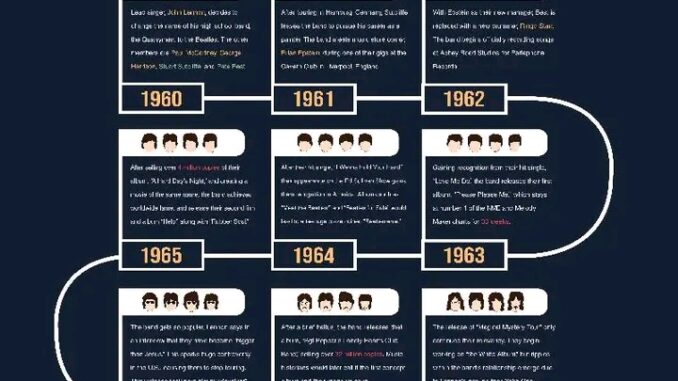
The Evolution of The Beatles: A Journey Through the Years
The Beatles, arguably the most influential band in the history of popular music, have left an indelible mark on the cultural landscape of the 20th century and beyond. From their humble beginnings in Liverpool to their status as global icons, the band’s evolution reflects not only changes within their music but also broader shifts in society, technology, and artistic expression. This article traces the remarkable journey of The Beatles through the years, highlighting their artistic innovations, cultural impact, and enduring legacy.
Early Years: Humble Beginnings in Liverpool (1950s – Early 1960s)
John Lennon, Paul McCartney, George Harrison, and Ringo Starr (joined in 1962) first came together in Liverpool in the late 1950s. Initially forming as The Quarrymen in 1957, they evolved into The Beatles by 1960, inspired by American rock and roll and skiffle music. Their early performances in clubs like The Cavern Club showcased their raw talent, energetic performances, and youthful exuberance.
During this period, their sound was heavily influenced by Chuck Berry, Little Richard, and Buddy Holly. Their debut single, “Love Me Do,” released in 1962, marked the beginning of their recording career. The song’s modest success was a stepping stone, but it was their relentless touring and magnetic personalities that built a dedicated fan base, setting the stage for their rapid rise.
Beatlemania and the British Invasion (1963-1965)
The Beatles’ breakthrough in the UK came with their second single, “Please Please Me,” which topped the charts. Their debut album, *Please Please Me* (1963), showcased their energetic style and catchy melodies. However, it was their arrival in the United States in 1964—culminating in their historic appearance on The Ed Sullivan Show—that ignited Beatlemania across America and globally.
This period was characterized by an unprecedented wave of adulation, media frenzy, and cultural influence. Their music was characterized by tight harmonies, innovative songwriting, and a youthful rebelliousness. Albums like *A Hard Day’s Night* (1964) and *Help!* (1965) reflected a band at the peak of their pop songwriting prowess.
Artistic Growth and Studio Innovation (1966-1967)
By the mid-1960s, The Beatles began to push beyond their initial pop formulas. Their 1965 album, *Rubber Soul*, showcased more sophisticated songwriting, lyrical depth, and experimentation with different musical styles, including folk and soul. This album marked a transition from pure pop to more meaningful and artistic music.
In 1966, they released *Revolver*, a groundbreaking album that featured innovative studio techniques, unconventional instruments, and complex arrangements. Tracks like “Eleanor Rigby” and “Tomorrow Never Knows” exemplified their move toward artistic maturity. This period also saw the band’s exploration of psychedelic sounds and studio experimentation, laying the groundwork for the psychedelic era.
The Psychedelic Era and Artistic Masterpieces (1967-1968)
1967 saw the release of *Sgt. Pepper’s Lonely Hearts Club Band*, often regarded as one of the greatest albums in history. Its concept album format, experimental production, and eclectic influences epitomized the psychedelic era. Tracks like “Lucy in the Sky with Diamonds” and “A Day in the Life” exemplified their artistic zenith, blending music, art, and innovative recording techniques.
Following this, *Magical Mystery Tour* (1967) and the soundtrack for the animated film *Yellow Submarine* further cemented their reputation as pioneers of studio innovation. Their embrace of Eastern philosophy, psychedelic imagery, and new recording technologies reflected their desire to push artistic boundaries.
The Breakup and Solo Endeavors (1969-1970)
Despite their artistic achievements, tensions within the band grew. The pressures of fame, creative differences, and personal issues culminated in their decision to disband in 1970. During this period, each member pursued solo projects, with John Lennon and Paul McCartney becoming prominent figures in the music scene.
The Beatles’ final studio album, *Let It Be* (1970), was recorded amidst internal conflicts but contains some of their most enduring songs like “Across the Universe” and “Let It Be.” Their legacy was cemented as pioneers who continually evolved, experimented, and influenced generations of musicians.
Legacy and Cultural Impact
The Beatles’ influence extends beyond their music. They transformed the music industry, popular culture, and societal norms. Their innovative use of the recording studio as an instrument changed the way music was produced. Their fashion, attitudes, and openness to experimentation helped shape the counterculture of the 1960s.
Their songwriting partnership—Lennon and McCartney—set new standards for lyrical depth and melodic complexity. George Harrison’s incorporation of Indian music and spirituality expanded the boundaries of Western pop. Ringo Starr’s distinctive drumming added a unique rhythmic signature.
Post-Breakup and Continued Influence
After their disbandment, each member pursued solo careers, with John Lennon and George Harrison producing critically acclaimed work. Lennon’s activism and tragic death in 1980 further mythologized his legacy. McCartney and Starr continued to perform and record, celebrating the band’s legacy through reunions and tribute projects.
The Beatles’ catalog remains a cornerstone of popular music. Their albums are continually reissued, remastered, and celebrated. Their influence can be heard across genres—rock, pop, psychedelia, punk, and beyond.
Conclusion
The evolution of The Beatles is a testament to artistic growth, innovation, and cultural influence. From their early days as Liverpool lads playing skiffle to their transformation into avant-garde pioneers, they exemplify the power of music to inspire, challenge, and unite. Their legacy endures, inspiring countless artists and captivating generations of fans worldwide. As history continues to unfold, The Beatles remain a symbol of creative exploration and the transformative potential of music.
Leave a Reply